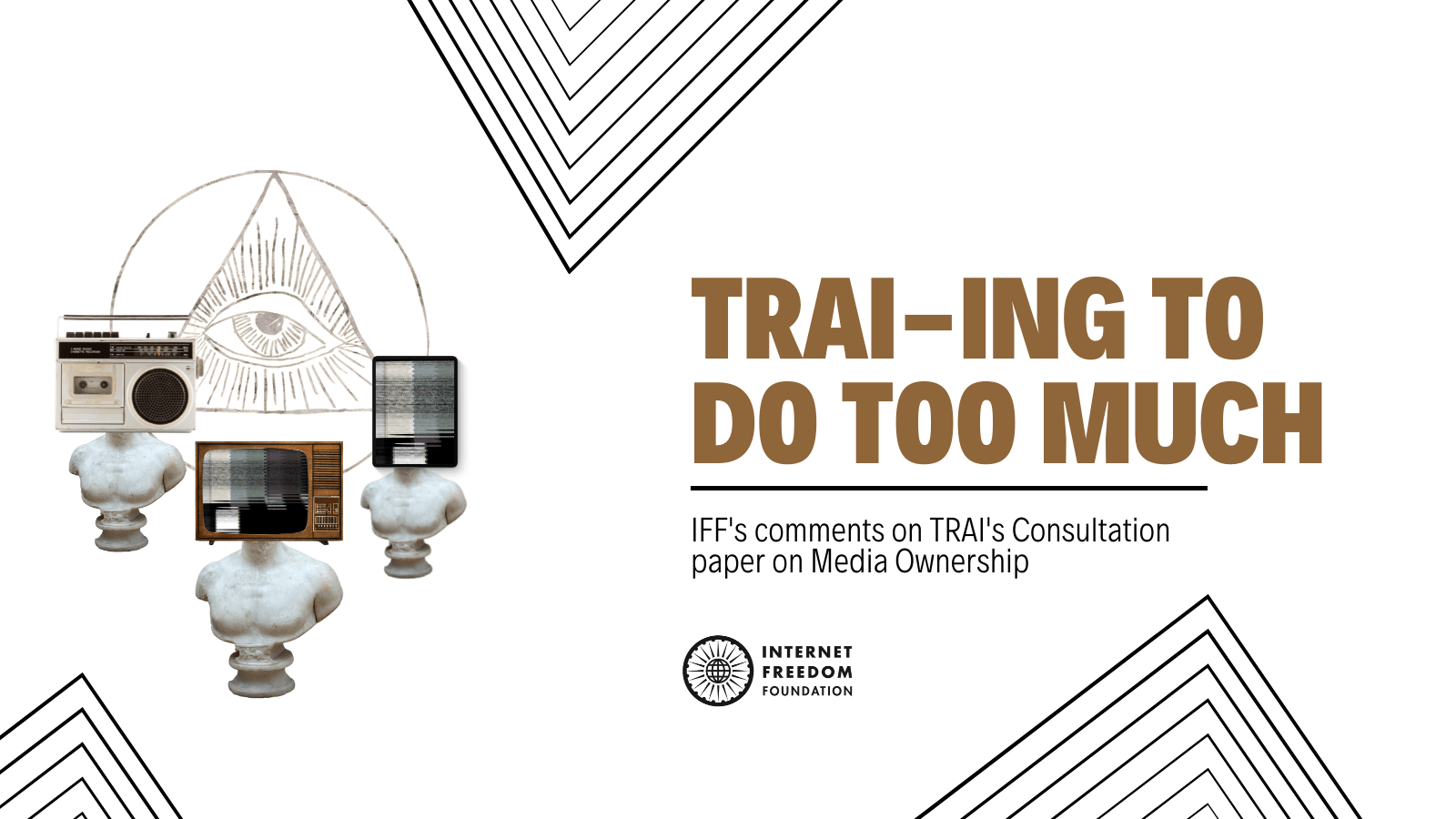
tl;dr
The Telecom Regulatory Authority of India (“TRAI”) released a consultation paper on “Issues relating to Media Ownership” on April 12, 2022. Highlighting that media pluralism is antithetical to the phenomenon of concentration of media ownership, the paper sought views on the need and method of regulation of cross-media ownership. We sent our comments on June 6, 2022, where we pointed out that regulation of cross media ownership will not necessarily lead to media pluralism, and that the former must not be done at the cost of freedom of speech and expression.
Why should you care?
The media landscape has expanded and undergone change in an unprecedented manner. Technological advancements in the past decade coupled with the push towards a digital lifestyle facilitated by the COVID-19 pandemic have significantly increased our consumption through the digital medium. It is thus of the absolute importance that all segments of media, i.e., print, television, radio, and the internet, represent diversity and viewpoint plurality. The consultation paper correctly recognises this need as well as the ills of concentration of media ownership or market dominance, which could lead to reduced quality of public debate. However, the approach adopted to address the issue is not as straightforward as implied in the paper. While placing restrictions on ownership of media companies may reduce market concentration, it might not necessarily lead to increased media plurality. However, unchecked regulations and restrictions could in fact negatively impact media freedom, thus reducing media plurality.
Introduction
The Ministry of Information and Broadcasting (“MIB”) on May 16, 2012, has called upon TRAI to suggest measures on cross media ownership with an aim of facilitating media plurality. After holding due consultation, TRAI, on August 12, 2014, issued “Recommendations on Issues Relating to Media Ownership”. In 2021, the MIB sought reconsideration of the 2014 recommendations made by TRAI, in the light of the technological developments in the media industry. TRAI, thus, issued this consultation paper (No. 04/2022), seeking comments of the need, nature and level of safeguards with respect to horizontal (ownership in two or more media segments) and vertical integration (multiple ownership by an entity in the same media segment) in various media sectors.
Referring to the dominance of a few players as well as the lack of accurate and authentic content in the digital media industry, TRAI made the case for the desirability of a media market regulator. It also outlines the limitations of the self-regulatory mechanisms prescribed by the Information Technology (Intermediary Guidelines and Digital Media Ethics Code) Rules, 2021, calling it “at best a Laissez-faire mechanism applicable only to those respecting the guiding principles”. The paper also questioned if the existing regulatory mechanisms are sufficient for media regulation or whether there was a need for a sector specific regulator to ensure media plurality.
Our Comments
- Trespassing by TRAI: The issues raised in the consultation paper range from ownership, control, distribution, regulation, restriction, etc. in various media segments such as print, television, radio and internet. Section 11(1) (a) of TRAI Act 1997 states, “measures to facilitate competition and promote efficiency in the operation of telecommunication services so as to facilitate growth in such services;…”. Through a notification dated January 9, 2004, the Central Government included broadcasting and cable services under TRAI’s ambit. Considering that its legislative mandate is restricted to “telecommunication, broadcasting and cable services”, providing recommendations on regulating or placing restrictions on print and digital media is beyond TRAI’s area of expertise and competence. Considering that the Ministry of Information and Broadcasting has referred this matter to TRAI, it is TRAI’s responsibility to restrict its suggestions and inputs to issues related to telecommunication and broadcasting services.
- A case of misdiagnosis: As correctly stated by TRAI in the consultation paper, dominance by a limited number of players, both across and within the media industry will reduce media pluralism. However, it might be important to note here that while monitoring/restricting cross-media ownership might reduce market dominance by larger players, it may not necessarily achieve the goal of viewpoint plurality. In spite of having representation of multiple voices on and across media segments, there could still be limited diversity in viewpoints. However, we do recognise the challenges created by media concentration in various segments of media. Thus, cross-media ownership and control must also be viewed from a perspective of controlling market dominance and concentration as well as ensuring healthy and fair market competition.
- Threat of increased compliance burden: With increased regulation, comes increased need for compliance. Any mechanism to monitor cross-media ownership must ensure that an additional compliance burden is not imposed on the entities. Additionally, the actions to address non-compliance must not be disproportionate and against the principle of media freedom. It must also be narrow in scope such that it does not hinder economic activity among small and medium-sized entities.
- Excessive state control: The paper invited comments on the possibility of the licensors’ restraining any entity from entering the media sector in public interest. Such a move may end up giving the state excessive power and control over the media which is undesirable. Empowering the regulator with such broad powers may also lead to threats such as content policing, removal, censorship, etc. Moreover, as we have stated earlier, restricting ownership may reduce market dominance but might not necessarily increase viewpoint plurality. Furthermore, making the regulator the sole authority capable of restraining entities from entering the media sector may create a substantial risk of abuse of power. There should, therefore, be multiple checks and balances in place along with sufficient grievance redressal mechanisms to help safeguard media freedom. Such a step may only be considered after the designated regulator has clear and defined standards/ tests to determine the impact on public interest arising from the entry of an entity in the media sector.
- Can restrictions coexist with media freedom?: The digital space has been a boon for journalists, whistleblowers and activists who now have more avenues to share their work with a wider audience. It also gave Indian audiences the ability to access a greater number of news sources. Further, it provided opportunities to many more small-scale, local news reporters who were previously unable to find space on traditional television, print and radio media. Thus, it must be ensured that any mechanism to monitor or regulate cross media ownership doesn’t encroach upon the media’s freedom of speech and expression promised by Article 19(1)(a) of the Indian Constitution. Media pluralism must not be at the cost of media freedom and greater state control over the industry.
Conclusion
Although we have responded to the consultation paper, we would like to reiterate our broader concerns that inviting comments and formulating recommendations on the regulations of media ownership in the print and digital media is beyond TRAI’s expertise and competence. TRAI must thus restrict itself from sending MIB recommendations on the aforementioned media segments. We would also like to restate our position that regulating/ restricting cross-media ownership will not necessarily lead to viewpoint plurality. However, any attempts to do so must be balanced against the freedom of speech and expression. It should also be considered from the perspective of market competition and not solely with the aim of increasing viewpoint plurality.
This post was primarily drafted by Tejasi Panjiar, Associate Policy Counsel, and reviewed by Prateek Waghre, Policy Director.
Important Documents:
- Consultation Paper on Issues relating to Media Ownership (link)
- Our comments on the Consultation Paper released by TRAI (link)
- TRAI Act 1997 (link)


